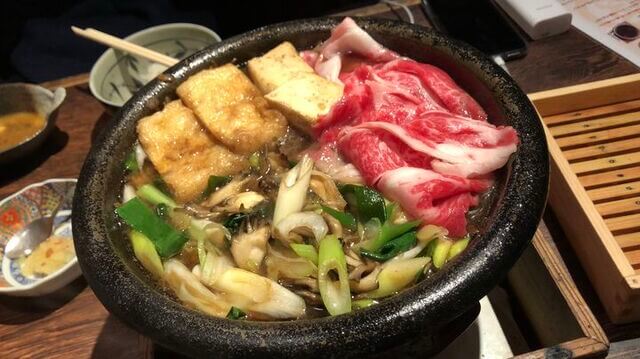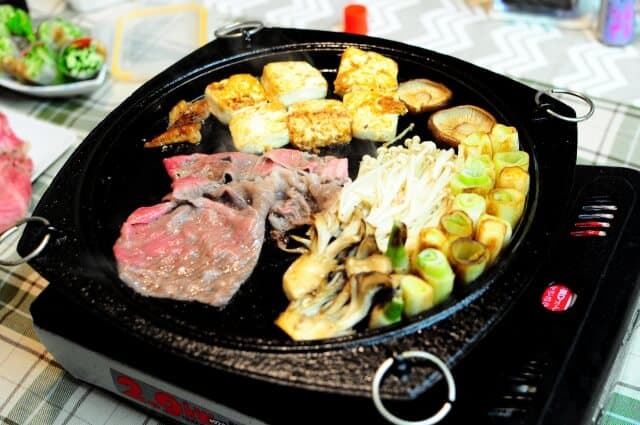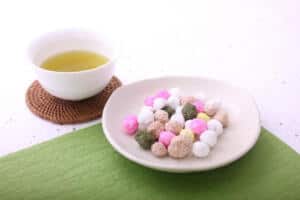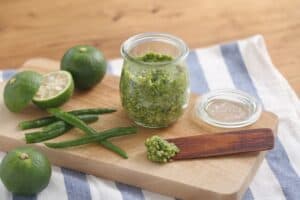If you are a fan of Japanese food, you may have heard or even tried sukiyaki before. However, do you know that there are more than one type of sukiyaki: Kansai style and Kanto style sukiyaki. Today, we want to introduce Kansai style Sukiyaki’s history and features. We are also going to recommend good restaurans for Kansai-style sukiyaki so please check it out below.
What is Kansai style sukiyaki?
Kansai style sukiyaki (関西風すき焼き) is a traditional Japanese hotpot and is a type of sukiyaki from the Kansai region made by grilling and eating the boiled meat and vegetables. The Kansai-style sukiyaki is generally grilled and eaten, rather than “simmering” vegetables and meat in a warishita style, as in the Kanto style. In the case of Kansai-style sukiyaki, locals first put the meat in a pan and cook it, then season it with sugar or soy sauce. Then, add the vegetables with the most water to the pot in order, and when cooked, add the beaten egg. This Kansai-style sukiyaki does not use warishita (a mixture of sake, soy sauce, sugar, mirin, and dashi) unlike the Kanto-style sukiyaki. Originally, it was common to eat meat first and then put vegetables and other ingredients on top of the remaining gravy and beef tallow.
Kansai style sukiyaki History

Sukiyaki appears to have come from Kansai based on its etymology. According to one theory, their ancestors used the farming tool “Suki” to grill fish in the middle of the Edo period. In such a trend, locals ate the beef secretly, and at the end of the Edo period, the first “sukiyaki shop” was born in the Sanjo River in Kyoto. When stewed beef pots were popular in the Kanto region, beef-based “sukiyaki” was popular in the Kansai region. However, in contrast to stewed beef pots, the meat, and other ingredients were cooked in a flat pot and a soup bowl. Locals prepare this by baking it after dipping it in raw eggs. The modern Kansai-style sukiyaki method is founded on this.
Kansai style sukiyaki Recipe

Kansai style sukiyaki Ingredients
| Ingredients of Kansai style sukiyaki for 2 person | |
| Sliced beef thigh | 200g |
| 150gYaki-dofu | 150g |
| Shirataki noodles | 100g |
| Onion | 15g |
| Green onions | 25g |
| Chinese cabbage | 40g |
| Chrysanthemum | 15g |
| Shiitake | 20g |
| Beef tallow | 20g |
| Sugar | 28g |
| Beaten egg | 100g |
| Liquor | 42g |
| Sugar | 42g |
| Soy sauce | 42g |
How to make Kansai style sukiyaki
Cut the onions into combs and the green onions diagonally. Then, cut Chinese cabbage and chrysanthemum into pieces that are easy to eat. Next, you should also cut off the root of shiitake mushrooms and the yaki-dofu into pieces that are easy to eat.
Put water and shirataki noodles in a pan, heat on medium heat, and boil for about 1 minute to drain.
Put the beef fat or tallow in a pan, heat on medium heat, and sprinkle an appropriate amount of sugar. Turn it over when it gets brown.
Place the beef on the edge of the pan and add 1 or 2 ingredients. Add in several batches and simmer until the vegetables are cooked. Lastly, add the raw eggs.
Do not add all the ingredients and seasonings at once, but add them while eating to get a good taste.
Cooking points for Kansai style sukiyaki

When making sukiyaki in the Kansai style, locals grill the beef in a particular pot, sprinkled with sugar, and then seasoned with soy sauce after it has been for about 80%. They add first the vegetable with the most water content when adding other vegetables. The Kansai style has a little stronger flavor than the Kanto style since it simply uses the natural water content of the vegetables.
Why do the Japanese start eating it with raw eggs?

Many of you may have heard that the goal is to cool hot meat and vegetables by passing them through raw eggs. There is a clause that eating with eggs was a typical manner of eating at a time when both beef and eggs were premium products. It seems to sense that sukiyaki has become popular since eating it once was considered a sign of modernity.
Kansai style sukiyaki vs Kanto style sukiyaki

Kanto-style sukiyaki uses a mixture of soy sauce, mirin, and sugar called warishita. Add vegetables such as green onions and Chinese cabbage to the boiled warishita, and they add the meat and boil. With the Kanto-style cooking method, each soup stock exudes when they boil the vegetables and meat, so they can enjoy the taste of the ingredients.
Unlike Kanto-style sukiyaki, where the point was to boil using warishita, the point of Kansai-style sukiyaki is “baking.” Kansai-style sukiyaki begins when you melt high-quality beef fat in a hot pot and bake the beef. Then season with soy sauce or sugar, add vegetables and make fine adjustments with sake or water. With this method, you can directly feel the taste of the meat, and the point is that it is easy to season it to your liking.
What kind of meat is sukiyaki?

Japanese usually used premium beef in their nabemono or hotpot dishes including sukiyaki. But they usually uses the thinly sliced beef for sukiyaki, although in the past, in certain parts of the country (notably Hokkaidō and Niigata) pork was also popular. Popular ingredients cooked with the beef are: Tofu (usually seared firm tofu). Negi (a type of scallion).
What does it mean to bake the meat first?

To be precise, it’s about coloring the meat and transferring its aroma to the meat. The roasted aroma of this meat complicates the aroma of sukiyaki and brings richness. What’s more, this grilled color will never come out. Since the temperature of the pot can only rise to 100 ° C, no matter how much water is heated, the temperature will only rise to 100 ° C. However, the temperature at which the color is browned must be 150 ° C or higher. If you add the ingredients, you can’t add yakimono unless all the broth has evaporated.
Which part of beef is good for Kansai style sukiyaki?

There are three recommended parts for sukiyaki: “rib meat,” “rib loin,” and “shoulder loin.”
Shoulder loin
The shoulder loin from the shoulder to the back is a part of lean meat that is relatively rich in fat and has a fine meat quality , so it is also suitable for eating as sliced meat.
Rib meat
Rib meat is the meat around the ribs. It has more fibers and a coarser texture than others, but it is reasonably easy to obtain, so it is a part that you want to make good use of.
Rib loin
The fine meat quality and just the right amount of marbling make it one of the best beef. Many believed that you can enjoy the original flavor and umami of meat.
Where to buy Kansai style sukiyaki
Hon Sekiguchi (本 せきぐち)

Sekiguchi is a long-established store specializing in sukiyaki that has been in business for 140 years. It is a unique restaurant that uses the finest Japanese black beef and has a unique sauce. The owner blended the beef tallow in an iron pan, laid with grain, and then grilled with high-quality beef.
Kitamura (北むら)

The sukiyaki specialty store “Kitamura”, has been operating in the same place since its establishment in 1887. The characteristics of the beef you receive at “Kitamura” are beautiful marbling and thickness. This sukiyaki is also a traditional Kansai style that starts with grilling beef in a Nanbu Tekki pot with beef melted without using warishita.
Kamiya (神谷)

Here, you can enjoy sukiyaki made with Tokushima brand beef “Waichi”, which is a small quantity on the market. At this restaurant, you can enjoy the first-class dishes offered and conversations with the makers, and the staff will cook sukiyaki in the best condition. After grilling the meat, you can cook the green onions and burdock, and lettuce, which is rare elsewhere, is also used as an ingredient.
Takeaway

Cooking techniques also differ between the two regions. To make sukiyaki, in the Kansai region beef is fried in fat and browned with sugar before adding liquid ingredients, while in Kanto the liquid ingredients are mixed to make a warishita sauce for simmering the meat. Some restaurants cook a slice of beef first for the customer to enjoy while the rest of the pot cooks and simmers in the liquid.
If you like this article about Kansai style sukiyaki, I bet you will also like the Kanto style sukiyaki, Sukiyaki, and Shabu-shabu articles.
















Comments